10 Tips For Forklift Operators This Fall
 As the leaves start to change color and fall, forklift drivers have to be extra careful. When summer turns into fall, there are new safety challenges to think about, like rain, less daylight, and colder weather. Here
are ten important tips to help you stay safe when driving a forklift in the fall.
As the leaves start to change color and fall, forklift drivers have to be extra careful. When summer turns into fall, there are new safety challenges to think about, like rain, less daylight, and colder weather. Here
are ten important tips to help you stay safe when driving a forklift in the fall.
1. Check Your Forklift
Before you start your forklift, give it a good look. Check for problems like worn-out tires, broken lights, or leaks. Fix them right away to keep your forklift safe. Imagine if you didn't fix a worn-out tire – it could cause an accident.
2. Be Ready for Less Light
In the fall, we have fewer daylight hours. This means you might have to work when it's not very bright outside. Make sure all your forklift lights work well. You can also wear bright clothes or a special vest to help others see you better. Think about how tricky it would be to drive without lights at night.
3. Watch Out for Slippery Surfaces
Fall brings wet leaves and rainy days, making surfaces slippery. When you see wet leaves, slow down and keep a safe distance from the forklift ahead. Wet leaves can be as slippery as ice, so driving carefully is a must.
4. Be Wary of Wind
Fall winds can be strong, especially when lifting heavy loads. Check the wind before you start. If it's very windy, consider waiting. Imagine trying to lift a heavy load in strong wind – it could tip your forklift over.
5. Dress Right for the Weather
Fall weather can change a lot during the day. Wear layered clothing that you can add or remove as needed. Wear shoes with good grip to prevent slips. Not wearing the right shoes might lead to falls and injuries. While it can get a bit colder, October and November highs in Texas are still enough to cause heat stroke. Staying hydrated through temperature fluctuation is still very important.
6. Secure Your Loads
Windy days can make unsecured loads shift, putting you and others in danger. Always use straps or pallets to secure your load tightly. Be extra cautious with large, lightweight items, as the wind can make them wobble. Imagine the wind pushing your load off your forklift – it could be a dangerous situation.
7. Stay Updated on the Weather
Keep an eye on the weather, especially if you're working outdoors. Knowing if it might rain or get windy helps you plan your day better. Imagine not checking the weather and getting caught in the rain – not fun. Extreme weather can play a factor in operator safety in certain parts of Texas. Flash floods, tornados and even hurricanes can cause massive disruptions to worksites.
8. Keep a Safe Distance
In the fall, it's harder to see clearly, so maintaining a safe distance from others is vital. Be ready to stop quickly if needed. Sometimes, it might be foggy, making it difficult to see well. If you drive too close to someone, it could be risky. Fall season typically brings the most the most fog in Texas.
9. Handle Rough Terrain with Care
If you drive on bumpy or uneven ground, like gravel or mud, be extra cautious in the fall. These surfaces can make your forklift tip over. Learn how to drive safely on them and watch out for obstacles. Imagine making a sharp turn on bumpy ground – it could be risky.
10. Keep Up to Date with Training
Use this time to improve your forklift skills. Learn more about safety and make sure your colleagues know the safety rules too. Taking a safety class can help you become a better forklift driver. Keep learning to be the best forklift operator you can be.
In Conclusion
To wrap it up, staying safe while driving a forklift in the fall means being careful and prepared. Use these ten tips, and remember that safety is crucial for everyone. Share these tips with your colleagues, and make sure everyone knows how to stay safe. Keep practicing and learning, so you can have a safe and productive fall season on your forklift.

